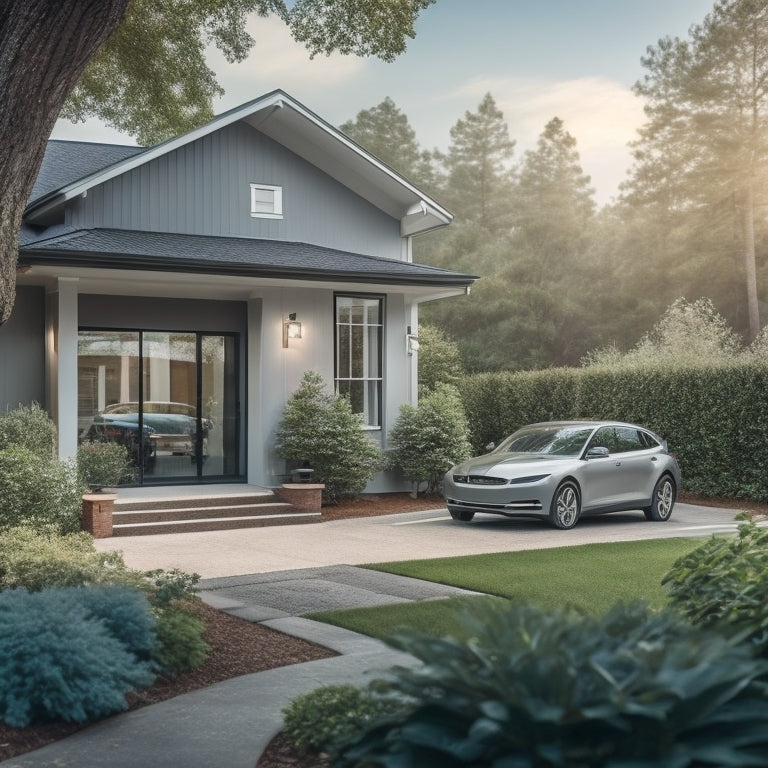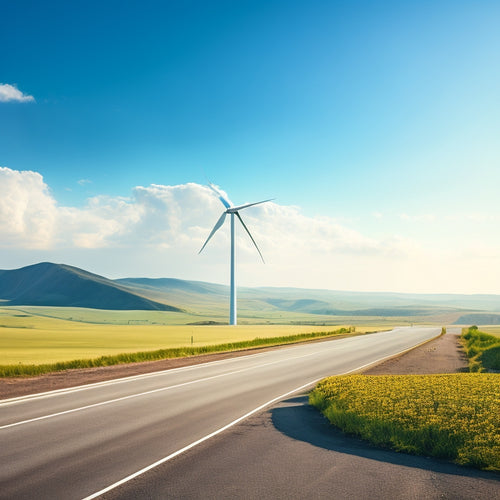
Electric Vehicle Charging Solutions for Your Home
Share
When setting up an electric vehicle charging solution at home, you'll want to explore a Vehicle to Grid (V2G) system. This technology enables a two-way flow of energy, reducing your carbon footprint and supporting the grid during peak hours. By harnessing excess energy for later use, you'll stabilize your power supply and even generate revenue. To get started, you'll need a specialized charging station and professional installation. As you delve into V2G solutions, you'll discover cost savings and incentives, including federal tax credits and state rebates. As you move forward, you'll find that the benefits of V2G technology will continue to unfold.
Key Takeaways
• Consider installing a Vehicle-to-Grid (V2G) system, enabling bi-directional energy flow and harnessing excess energy for later use.
• Ensure a specialized charging station is installed, facilitating bi-directional energy flow and optimizing energy distribution.
• Take advantage of cost savings and incentives, including Federal Tax credits, state rebates, and utility discounts, to reduce installation costs.
• V2G technology helps stabilize the grid during peak hours, supports grid resilience, and contributes to a more sustainable energy future.
• A well-designed V2G system provides energy independence, reduces carbon footprint, and generates revenue through optimized energy distribution.
Benefits of Vehicle to Grid
As you plug your electric vehicle into the grid, you enable a two-way flow of energy, allowing your car to act as a virtual power plant, feeding energy back into the grid and providing a multitude of benefits.
This Vehicle-to-Grid (V2G) technology not only reduces your carbon footprint but also supports the grid during peak hours, reducing the strain on the electrical infrastructure. By feeding energy back into the grid, you're contributing to a cleaner, more sustainable energy mix, minimizing the environmental impact of transportation.
Additionally, V2G technology allows for Energy Independence, giving you control over your energy consumption and production. With the ability to store and release energy as needed, you can optimize your energy usage, reducing your reliance on the grid and saving on your energy bills.
As the energy landscape continues to evolve, V2G technology is poised to play a critical role in the shift to a more sustainable, decentralized energy system.
How V2G Technology Works
You initiate the Vehicle-to-Grid (V2G) process by plugging your electric vehicle into a specially designed charging station, which enables a bi-directional flow of energy. This advanced technology allows your vehicle to act as an energy storage device, feeding electricity back into the power grid when not in use.
As you charge your vehicle, the V2G system harnesses excess energy and stores it for later use, making you an active participant in energy harvesting. When the grid is under high demand, your vehicle can supply energy back to the grid, stabilizing the power supply and generating revenue for you.
This symbiotic relationship between your vehicle and the grid optimizes energy distribution, reducing strain on the power grid during peak hours. By leveraging V2G technology, you're not only contributing to a more efficient energy ecosystem but also opening up new revenue streams.
As you explore the possibilities of V2G, you'll discover a future where electric vehicles are no longer just modes of transportation, but also integral components of the energy infrastructure.
Installing a V2G System
To integrate your electric vehicle into the grid as a V2G-enabled energy storage device, you'll need to install a specialized charging station and accompanying hardware that facilitates bi-directional energy flow. This setup allows your vehicle to act as an energy storage unit, feeding excess energy back into the grid when not in use.
When designing your V2G system, you'll need to take into account the system design, considering factors such as the capacity of your vehicle's battery, the power output of your home's electrical system, and the energy demands of your household. A well-designed system will guarantee seamless home integration, allowing you to harness the full potential of V2G technology.
A professional installer can help you navigate the complexities of system design and installation, ensuring a safe and efficient integration with your home's electrical infrastructure. With a properly installed V2G system, you'll be able to tap into the benefits of vehicle-to-grid technology, including reduced energy costs and a more sustainable energy future.
Cost Savings and Incentives
By adopting vehicle-to-grid technology, homeowners can access significant cost savings and incentives that can help offset the initial investment in a V2G system. As a homeowner, you can take advantage of the Federal Tax credit, which provides a tax credit of up to $7,500 for the purchase of a qualifying V2G system. Additionally, many states offer rebates and incentives for V2G adoption, which can further reduce the upfront cost.
You may also be eligible for utility discounts, as V2G systems can help stabilize the grid and reduce peak demand. Substantially, some insurance providers offer lower insurance rates for V2G-equipped vehicles, recognizing the added safety and security features. By combining these incentives, you can substantially reduce the overall cost of owning and operating a V2G system.
As you consider investing in a V2G system, be sure to research the specific incentives available in your area and factor them into your decision-making process.
Future of V2G Charging
As the automotive industry continues to shift towards electrification, vehicle-to-grid (V2G) charging is poised to play a pivotal role in the future of electric vehicle (EV) infrastructure. This technology enables your EV to supply energy back to the grid, creating a two-way flow of electricity. You'll not only charge your vehicle but also contribute to grid resilience.
| Benefits | Description |
|---|---|
| Grid Stability | V2G charging helps stabilize the grid by absorbing excess energy during off-peak hours and supplying it back during peak hours. |
| Peak Shaving | Your EV can reduce peak demand on the grid, reducing strain on the infrastructure and preventing blackouts. |
| Renewable Integration | V2G enables the efficient integration of renewable energy sources, such as solar and wind power, into the grid. |
As you consider V2G infrastructure for your home, you'll be at the forefront of a revolution in EV charging. By embracing this technology, you'll not only reduce your carbon footprint but also contribute to a more resilient and sustainable energy future.
Frequently Asked Questions
Can I Charge My Electric Vehicle With a Standard Household Outlet?
"Think you're stuck in the slow lane? Think again! You can charge your electric vehicle with a standard household outlet, but be cautious of outlet safety and prepare for slower charging speeds, around 4-5 miles per hour."
Are Electric Vehicle Charging Stations Compatible With All EV Models?
'When you're wondering if charging stations are compatible with all EV models, rest assured that most adhere to EV standards, ensuring vehicle compatibility; however, make sure to check your vehicle's specs to confirm compatibility before investing in a station.'
How Long Does It Take to Fully Charge an Electric Vehicle at Home?
"As you plug in, imagine your EV's battery as a thirsty camel at an oasis - it's a relief! Your charging speed depends on your EV's power consumption; typically, a 240-volt Level 2 charger takes 4-8 hours to fully charge, while a 120-volt Level 1 charger takes 12-24 hours."
Do I Need a Dedicated 240-Volt Charging Station for My Electric Vehicle?
You'll need a dedicated 240-volt charging station for your electric vehicle if you want faster charging and reduced energy costs, as it can cut your charging time in half and lower your overall charging cost.
Can I Install an Electric Vehicle Charging Station Myself?
You can try installing an electric vehicle charging station yourself, but be aware of DIY challenges, like ensuring a safe electrical connection, and safety concerns, such as avoiding electrical shock, which may outweigh any cost savings.
Related Posts
-

Charge Your Ride With Renewable Energy Solutions
By immersing yourself in renewable energy sources like solar power, you can greatly diminish your carbon footprint an...
-

What's the Best Green Ride for College Budgets?
As a college student on a budget, you're likely looking for an eco-friendly ride that won't break the bank. You've go...
-

Why RV Owners Need Solar Panels for Battery Life
You can greatly extend the life of your RV's batteries by switching to solar power. By harnessing the sun's energy, y...


